-
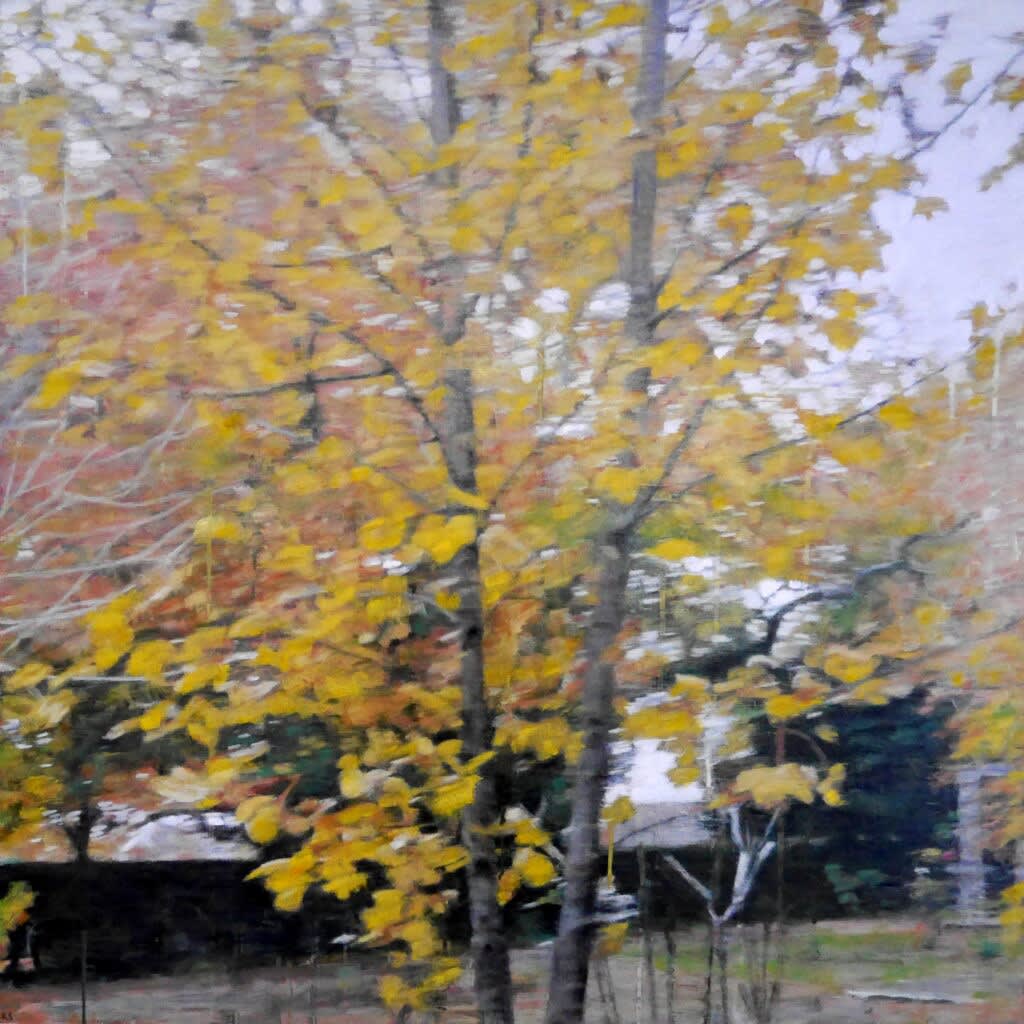
Kate Sherman: Park, 100 x 100 cm, oil on panel, 2019
We recently took delivery of the most beautiful series of paintings by artist Kate Sherman whose work was intended to be part of our Dulwich Festival show, a Green and Pleasant Land. Kate is a relatively new addition to the Cavaliero Finn portfolio but her paintings sit so perfectly alongside many of our other artists’ work that it feels like we have always exhibited them.

Kate Sherman in front of one of her paintings from the Coast Series
Kate’s latest body of work is inspired by an area of woodland a short walk from her home in Ditchling, in Sussex. These beautiful, silent paintings are slightly blurred, like a snapshot from a passing car window, offering us an isolated part of someone’s narrative that we may never fully comprehend. The beguiling sense of mystery draws us in, forcing us to ask questions about the scenes depicted.
This week, we settled down with a cup of tea to catch up with Kate and discover more about her latest work and her practice in general.
CF: Kate, as a nation in lockdown many of us have been increasingly aware of the natural world around us. Has this period of lockdown influenced your work and if so, how?
KS: I’ve been much busier during lockdown mainly because of home-schooling but have tried to paint a little each day. I had started some smaller woodland studies at the start of the year, and these have become my focus during the lockdown. They are of a wooded area near my home, 10 mins walk away, that have in them a small group of silver birch trees. I have become somewhat obsessive about photographing them each week at different times of day, different weathers etc, and noticing the changes as the season’s progress. The resulting paintings are mostly about light, the way the pale birch trunks reflect and behave in different lights. In some ways, the lockdown has felt a bit like time standing still but going to the woods you see nature carrying on regardless and it’s quite comforting and grounding.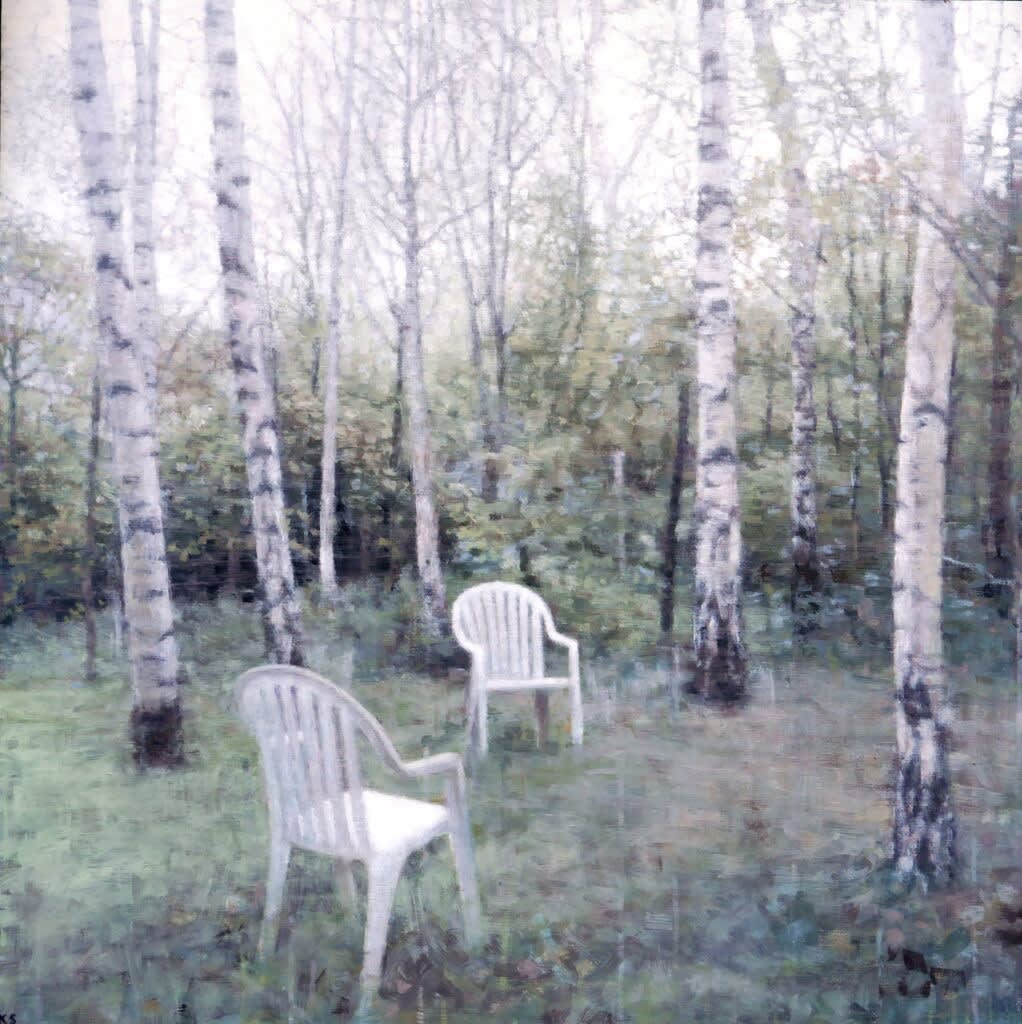
Kate Sherman: Chairs, 80 x 80 cm, oil on panel, 2019
CF: Can you give us a little more insight into this series of Woodland works? Your work always points to the symbiotic relationship we have with nature, the suggestion of human presence given by a discarded plastic chair in the woods for example. Can you tell us about this?
KS: I started this woodland series a year ago, just after a very close friend had died. I started painting the woods but felt something was missing compositionally and conceptually. I needed an object to be in amongst the trees, and I thought it should be white (to work formally), so had the idea of the plastic chairs. I liked the juxtaposition of the chairs against the silver birch trees. It wasn’t until I had finished the series and had all the paintings in the studio that it occurred to me that the empty chairs spoke so obviously about loss. Other paintings in this series have white tape tied around the trees forming barriers and dividing off/protecting different areas.
Kate Sherman: Woods 3, 35 x 35 cm, oil on panel, 2020
Also shown an installation of core vases by Mizuyo Yamashita
CF: What other themes do you pursue in your work?
KS: Common themes I go back to time and time again are memory, longing, childhood, isolation and the everyday.CF: How do you start a series of works? What are the main triggers, do you think?
KS: A new series usually starts as just one or two paintings and then if an idea takes hold it may turn into a series. Quite often the starting point will be a photo or photos which I took a while ago and have been in the back of my mind, it could be triggered by seeing something on TV, in a magazine, online, anywhere really.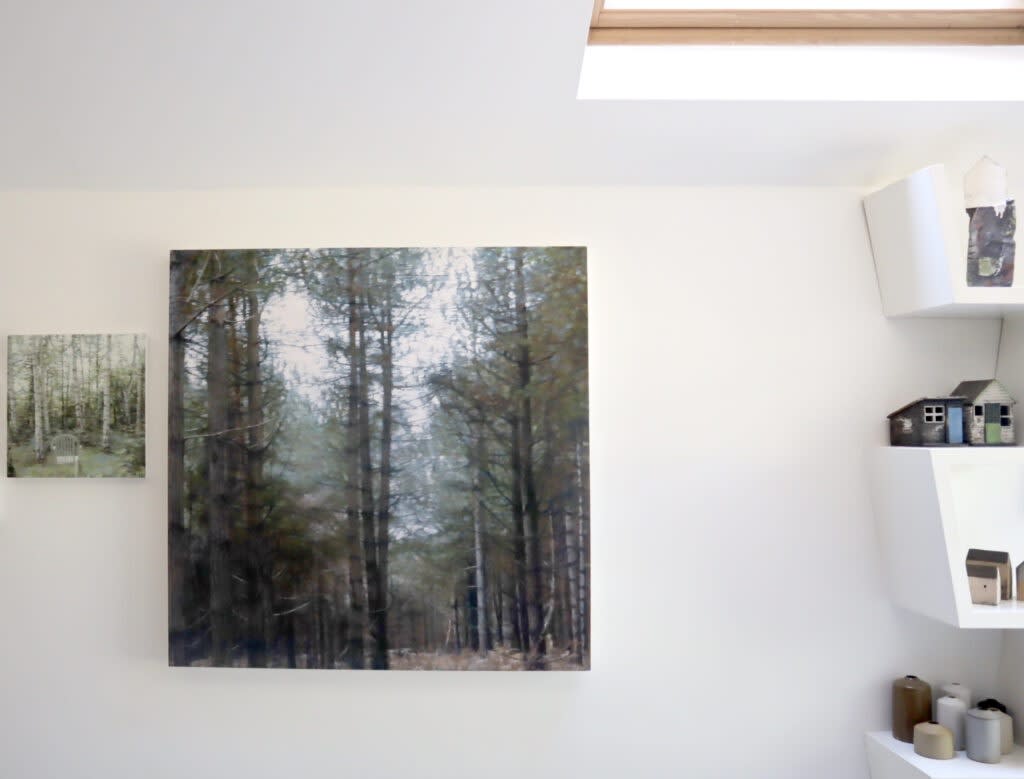
Kate Sherman: Forest 1, 100 x 100 cm, oil on panel, 2018 (center)
Woods 5, 35 x 35 cm, oil on panel 2020 (left)Also shown a selection of work by Rowena Brown and an installation of core vases by Mizuyo Yamashita
CF: You mention photography, what role does that play in your work?
KS: Photography is hugely important, both as a tool (all my paintings are worked from photographs) and as an aesthetic. It is important that the finished painting resembles a photograph, partly because I think this enables a stronger sense of narrative, and also to connect with our current reality of so much being experienced through a lens. But I would not really describe the paintings as ‘photo-realist’ because the paint itself is also really important, and when you see the works close up the image tends to dissolve under the layers and brushwork & mark-making.
Kate Sherman: Woods 1, 35 x 35cm, oil on panel, 2020
CF: There is a real sense of warmth in much of your work, how do you achieve this technically? Can you tell us a bit about the paints you work with and the process involved in developing each painting?
KS: The warmth may be due to always starting with a red ground (underpainting) which often comes through on the finished work. I then work in layers, with oil paint (thinned with turps & linseed oil), using strips of card to blend and blur the paint between layers. I pretty much always stick to the same palette of 5 or 6 colours and mix all the variants from them. The surface is a plywood panel; I prefer this to canvas as it allows me to scrape the paint across the firmer surface.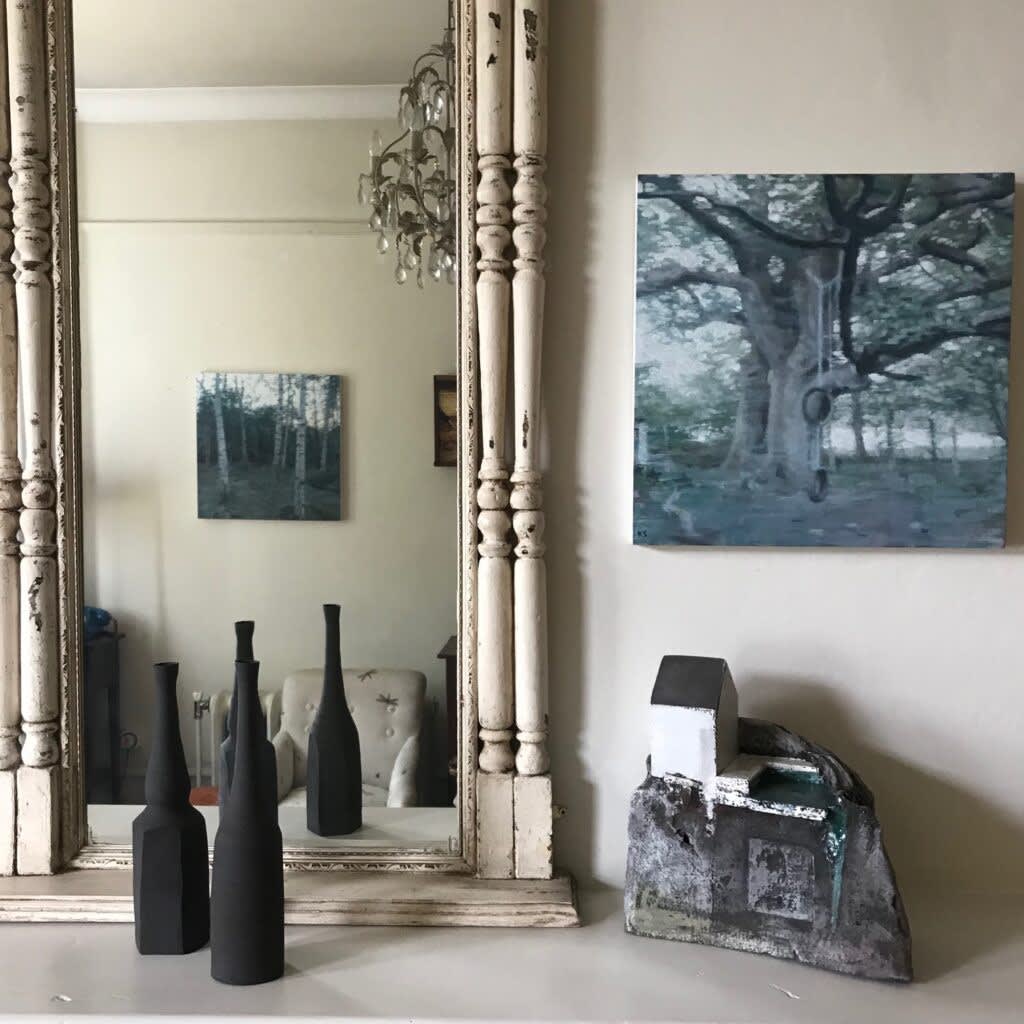
Kate Sherman: Woods 8, 35 x 35cm, oil on panel, 2020
Reflected in the mirror: Woods, Dusk 35 x 35cm, oil on panel, 2020
Also shown: Rowena Brown, House Built on Rock with Pool, stoneware, hand built architectural form, coloured with slips, part-glazed, 2019. Akiko Hirai , Still Life Bottle (sold – more stock coming)CF: What does art mean to you?
KS: Art to me is communication, and a way of connecting emotionally.
CF: Do you have a piece of art that is important to you and why?
KS: I have collected a few pieces over the years, maybe the most important to me is a painting by my mum. She was a secondary school teacher and took up painting when she retired. Unfortunately, she died very soon after and so didn’t produce many paintings. The one I have is of the Cobb at Lyme Regis, near where we lived. I love its simple composition and subdued colour, and of course, because it’s by her.
Illegitimate III 1997 Luc Tuymans
CF: Which artists inspire you?
KS: I’m mostly drawn to work by David Hockney, William Nicholson, Richard Diebenkorn, Luc Tuymans, Gerard Richter, Chantal Joffe, Vilhelm Hammershøi, George Shaw, Isaak Levitan, and Diane Arbus.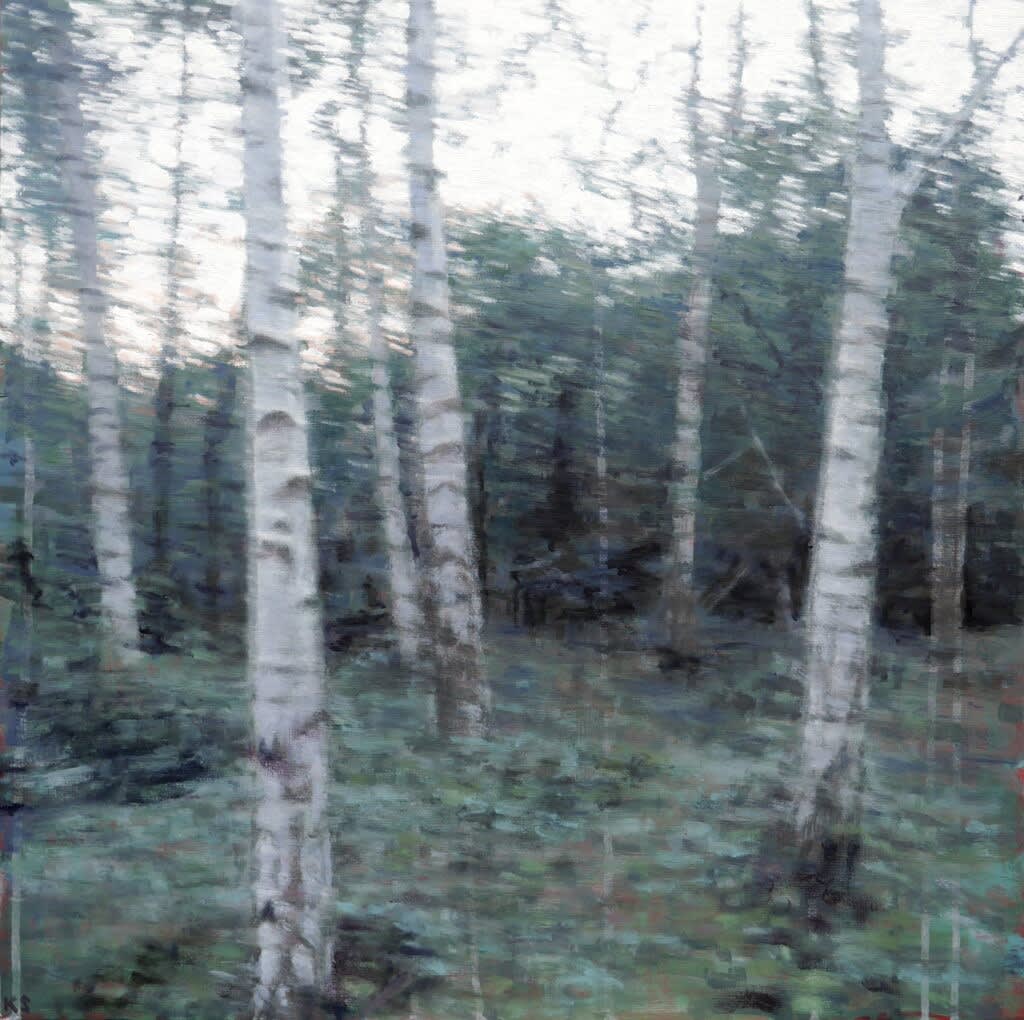
Kate Sherman: Woods, Dusk, 60 x 60cm, oil on panel, 2019
CF: Before becoming a full-time artist you worked in a gallery for many years. Can you tell us about this?
KS: I started as dog-walker, progressed to technician & then gallery manager. It was very inspiring working with world-renowned artists and handling their art; dealing with very wealthy clients was definitely an eye-opener, and there was a lovely camaraderie between different galleries.
CF: What do you think this experience brings to your practice as an artist today?
KS: I was exposed to so much art every day for ten or so years. I went to art fairs, exhibitions and auctions, and all this has fed into my practice. I wasn’t making very much art at that time, but that whole experience has definitely informed the work I am making now.CF: Thank you for talking to us Kate.
If you would like to find out more about Kate Sherman, do please go to her page in our artist’s section of the website.
We also post regular updates and sometimes videos on each of our artists on social media. So, if you don’t already, do follow us using those links.